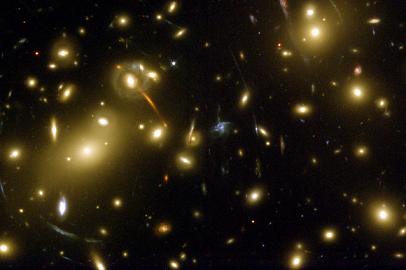
The HST WFPC2 image of gravitational lensing in the galaxy
cluster Abell 2218, indicating the presence of large amount of
dark matter (credit Andrew Fruchter at STScI)
For all you dark matter and dark energy fans out there, now
there’s another new “dark” to add to the list. It’s called “dark
gulping,” and it involves a process which may explain how
supermassive black holes were able to form in the early
universe. Astronomers from the University College of London (UCL)
propose that dark gulping occurred when there were gravitational
interactions between the invisible halo of dark matter in a
cluster of galaxies and the gas embedded in the dark matter
halo. This occurred when the Universe was less than a billion
years old. They found that the interactions cause the dark
matter to form a compact central mass, which can be
gravitationally unstable, and collapse. The fast dynamical
collapse is the dark gulping.
Dr. Curtis Saxton and Professor Kinwah Wu, both of UCL’s Mullard
Space Science Laboratory, developed a model to study the
process. They say that the dark gulping would have happened very
rapidly, without a trace of electro-magnetic radiation being
emitted.
There are several theories for how supermassive black holes
form. One possibility is that a single large gas cloud
collapses. Another is that a black hole formed by the collapse
of a giant star swallows up enormous amounts of matter. Still
another possibility is that a cluster of small black holes merge
together. However, all these options take many millions of years
and are at odds with recent observations that suggest that black
holes were present when the Universe was less than a billion
years old. Dark gulping may provide a solution to how the
slowness of gas accretion was circumvented, enabling the rapid
emergence of giant black holes. The affected dark mass in the
compact core is compatible with the scale of supermassive black
holes in galaxies today.
Dark matter appears to gravitationally dominate the dynamics of
galaxies and galaxy clusters. However, there is still a great
deal of conjecture about origin, properties and distribution of
dark particles. While it appears that dark matter doesn’t
interact with light, it does interacts with ordinary matter via
gravity. “Previous studies have ignored the interaction between
gas and the dark matter,” said Saxton, “but, by factoring it
into our model, we’ve achieved a much more realistic picture
that fits better with observations and may also have gained some
insight into the presence of early supermassive black holes.”?
According to the model, the development of a compact mass at the
core is inevitable. Cooling by the gas causes it to flow gently
in towards the center. The gas can be up to 10 million degrees
at the outskirts of the halos, which are few million light years
in diameter, with a cooler zone towards the core, which
surrounds a warmer interior a few thousand light years across.
The gas doesn’t cool indefinitely, but reaches a minimum
temperature, which fits well with X-ray observations of galaxy
clusters.
The model also investigates how many dimensions the dark
particles move in, as these determine the rate at which the dark
halo expands and absorbs and emits heat, and ultimately affect
the distribution of dark mass the system.
“In the context of our model, the observed core sizes of galaxy
cluster halos and the observed range of giant black hole masses
imply that dark matter particles have between seven and ten
degrees of freedom,”?said Saxton. ?”With more than six, the
inner region of the dark matter approaches the threshold of
gravitational instability, opening up the possibility of dark
gulping taking place.?
The findings have been published in the Monthly Notices of the
Royal Astronomical Society.
Source: RAS